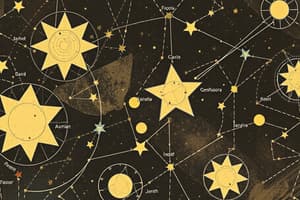Podcast
Questions and Answers
What are stars?
What are stars?
Hot, self-luminous gaseous celestial bodies.
Are stars very bright or not very bright?
Are stars very bright or not very bright?
False (B)
What do stars vary in?
What do stars vary in?
Size, color, luminosity, temperature, and age.
What does luminosity measure?
What does luminosity measure?
What is the relationship between a star's color and its temperature?
What is the relationship between a star's color and its temperature?
How does color change as temperature increases?
How does color change as temperature increases?
What is the relationship between a star's color and temperature?
What is the relationship between a star's color and temperature?
How do the luminosity and radius of stars compare?
How do the luminosity and radius of stars compare?
How do the radii of stars compare with their mass?
How do the radii of stars compare with their mass?
As the radius of a star increases, how does its luminosity change?
As the radius of a star increases, how does its luminosity change?
How does the mass of a star relate to its luminosity?
How does the mass of a star relate to its luminosity?
How does the radius of a star relate to its mass?
How does the radius of a star relate to its mass?
Why does the size of a star affect its luminosity?
Why does the size of a star affect its luminosity?
What is the relationship between mass and luminosity?
What is the relationship between mass and luminosity?
What is the relationship between mass and radius?
What is the relationship between mass and radius?
Why is Spica the densest star among Antares, Spica, and Polaris?
Why is Spica the densest star among Antares, Spica, and Polaris?
How is a star's luminosity related to its temperature?
How is a star's luminosity related to its temperature?
Which group are most stars found in?
Which group are most stars found in?
How can plotting two different characteristics on a graph help find relationships?
How can plotting two different characteristics on a graph help find relationships?
Is a yellow star like the sun hotter or cooler than a red star?
Is a yellow star like the sun hotter or cooler than a red star?
Why do blue main sequence stars have shorter lives than red main sequence stars?
Why do blue main sequence stars have shorter lives than red main sequence stars?
Amongst main sequence stars, how does temperature relate to luminosity?
Amongst main sequence stars, how does temperature relate to luminosity?
Describe how a star's luminosity and surface temperature change.
Describe how a star's luminosity and surface temperature change.
What are the characteristics of giants and supergiants?
What are the characteristics of giants and supergiants?
What are the characteristics of white dwarfs?
What are the characteristics of white dwarfs?
How will the sun's luminosity and temperature change as it ages?
How will the sun's luminosity and temperature change as it ages?
Flashcards are hidden until you start studying
Study Notes
Star Classification
- Stars are hot, self-luminous gaseous celestial bodies found throughout the universe.
- Brightness is classified as either very bright or not very bright.
Variability of Stars
- Stars exhibit variations in size, color, luminosity, temperature, and age.
- Luminosity measures a star's brightness relative to the sun, assuming equal distance from any observer.
Color and Temperature
- Orange and white stars are cooler than blue stars, indicating a direct relationship between color and temperature.
- As a star's temperature rises, its color changes, typically becoming blue.
Relationships Between Stars' Properties
- The luminosity of a star increases with its radius, demonstrating a direct relationship.
- Larger radius in stars correlates to increased mass.
- Increased radius also results in greater luminosity, suggesting a significant interplay between these properties.
Mass, Luminosity, and Radius
- Higher mass in stars is associated with increased luminosity.
- The biggest stars exhibit the highest luminosity due to their substantial mass.
Density of Stars
- Spica is identified as the densest star compared to Antares and Polaris due to its high mass relative to its low radius.
Luminosity and Temperature
- Luminosity and temperature are inversely related in some contexts; as luminosity increases, surface temperature may decrease.
- Most stars are categorized within the main sequence on the Hertzsprung-Russell diagram.
Relationships through Graphing
- Plotting different star characteristics can reveal relationships, such as between luminosity and temperature, age, color, and mass.
Star Lifespans
- Yellow stars, like the sun, are hotter than red stars.
- Blue stars are hotter and consume their fuel more quickly, leading to shorter lifespans compared to red stars.
Main Sequence Stars
- There is a positive correlation between temperature and luminosity among main sequence stars.
Changes in Luminosity and Temperature Over Time
- As stars evolve, their luminosity and surface temperature can change: for example, the sun will become a supergiant, experience an increase in luminosity and a drop in temperature, and eventually evolve into a white dwarf, where luminosity decreases while the temperature remains high.
Characteristics of Different Types of Stars
- Giants and supergiants are characterized by being large, massive, bright, and having a cool temperature.
- White dwarfs are small, dim, and exhibit high temperatures.
Studying That Suits You
Use AI to generate personalized quizzes and flashcards to suit your learning preferences.




